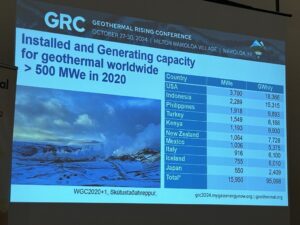Last month, Cascade Institute fellows Leighton Gall, Emily Smejkal, and Rebecca Pearce attended the Geothermal Rising Conference (GRC), in Waikaloa, Hawaii.
The conference featured highly technical scientific presentations on emerging projects, methods and technologies, as well as conversations on policy, communications, and financing. The conference covered all forms of geothermal, from geoexchange systems to ultradeep.
Each of the fellows presented or chaired sessions at the conference or its offshoot symposiums and summit. Their session recaps are below.
Emily Smejkal chaired a session on Regional Updates with Dr. Catherine Hickson. Several highlights around regional geothermal development emerged from the session:
- The market in Europe is more favourable for both geothermal heat and power. The war in the Ukraine has raised energy prices to unsustainable levels, making geothermal a financially viable option. District heating systems are more common here as well, making the conversion to geothermal heat simpler.
- A key boost to the US geothermal industry is the recent inclusion of geothermal in the long-term plans of power providers. For example, California mandated that their grid must include 2GW of geothermal by 2030!
- In the US, permitting of transmission and distribution are a major barrier to development. Work is currently underway to streamline permitting, but it is something we need to keep in mind in Canada. Work should be done concurrently with subsurface development.
Leighton Gall participated in the Indigenous Geothermal Symposium and moderated the North America Indigenous Projects segment, which offered an opportunity for cross-cultural learning and collaboration:
The Indigenous Geothermal Symposium (IGS) was coordinated by the Indigenous GRC rep Jessica Eagle-Bluestone, who impressively integrated the different different cultures and communities in the room. The symposium was attended by Indigenous representatives from USA, Canada, New Zealand and Taiwan.
The room was packed, often with standing room only, and there was strong participation by journalists and government officials.
A large component of the symposium was dedicated to working out the Indigenous Geothermal Declaration, which was developed by mixed nation breakout groups. Key themes from the declaration include:
- Recognition of Indigenous rights and sovereignty over natural resources
- Communication
-
-
-
- Indigenous community involvement
- Transparency
- Accessibility
- relationship building
-
-
- Community benefits
-
-
-
- Reciprocity and upfront internal capacity building
- Support self-governance
-
-
- Preserve cultural knowledge & environmental guardianship
- Early engagement and meaningful integrated partnership
- Establish common values and guiding principles that strive for consensus
-
-
- Environmental policy & continuity
- Develop international standards for Indigenous community engagement
-
-
The symposium underscored the importance of creating a centralized Indigenous database and information repository to strengthen geothermal knowledge mobilization. A dedicated committee with Indigenous representation within an international geothermal organization could serve as a valuable platform for coordination and inclusion. Canada can further scale up and accelerate technological adoption by prioritizing Indigenous participation in face-to-face meetings, drawing inspiration from similar initiatives led by Native Hawaiian and Māori communities. Such steps would foster deeper collaboration and ensure Indigenous voices are integral to the advancement of geothermal initiatives.
Rebecca Pearce was a panelist at the Clean Air Task Force (CATF) Superhot Rock Summit (held the weekend preceding the conference), featuring experts from around the world to discuss and strategize “Super Hot” geothermal systems. Super hot geothermal systems are a subset of next-generation geothermal systems that target rock temperatures greater than 374oC:
Panels covered the six reports in the recently published CATF technology gap series were discussed in panels. Rebecca participated in the panel on Siting Characterization. The discussion centered around finding the best methods to characterize geothermal resources and de-risk exploration. The report covers heat mapping, seismicity, exploration drilling, and electromagnetics. Panelists suggested that a global research consortium was needed to expedite data collection and analysis, which could encourage data sharing and collaboration across industry and academia.
Rebecca also participated in strategy mapping sessions to examine and prioritize key R&D gaps. Takeaways from the sessions include:
- Drilling: There have been remarkable recent advances in drilling speed, which continue to bring down the cost of geothermal development, but additional improvements are needed to further improve project economics.
- Topside Equipment: Modularity of ORC plants and turbine equipment will improve project economics.
- Well Completion: Cement remains the weakest link. We need more high-pressure, high-temperature testing and to move away from solid cement.
- Reservoir Creation: As this technology domain is the most unknown, modelling is required to address uncertainty at this stage.
- Site Characterization: Temperature gradients and stress at depth are the hardest and most crucial parameters to resolve.
The conference clearly illustrated that the US is the global leader in geothermal research with initiatives such the DOE Lift-off Report or GEODE. Canada’s interest in geothermal is increasing, and a strong partnership with our Southern neighbours could leverage Canadian talent in subsurface development and foster innovation across both nations.
Another takeaway was the need to plan geothermal grid connections concurrently with project development. Permitting and construction for transmission and distribution can be lengthy and complicated. This planning must be initiated now as the geothermal industry gains traction in North America.
Of the 1,200 conference attendees, five percent identified as Canadian. While geothermal heating is becoming more common globally, it is still underutilized in Canada. 78% of all energy used in Canada is for space and water heating. Presently, Canada has only one co-producing geothermal power facility, but there is an huge opportunity to build more. The momentum of the international geothermal industry was obvious throughout the conference. By leveraging this momentum, Canada can unlock reliable power and heat, while creating a new industry.



